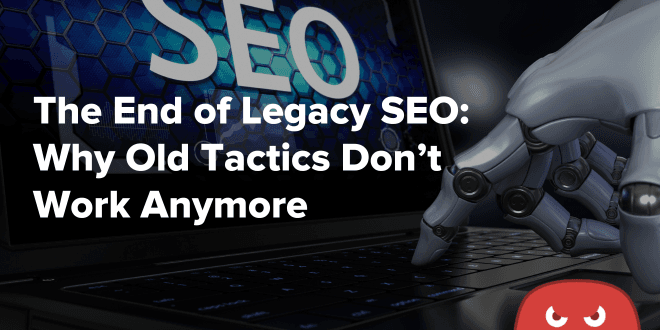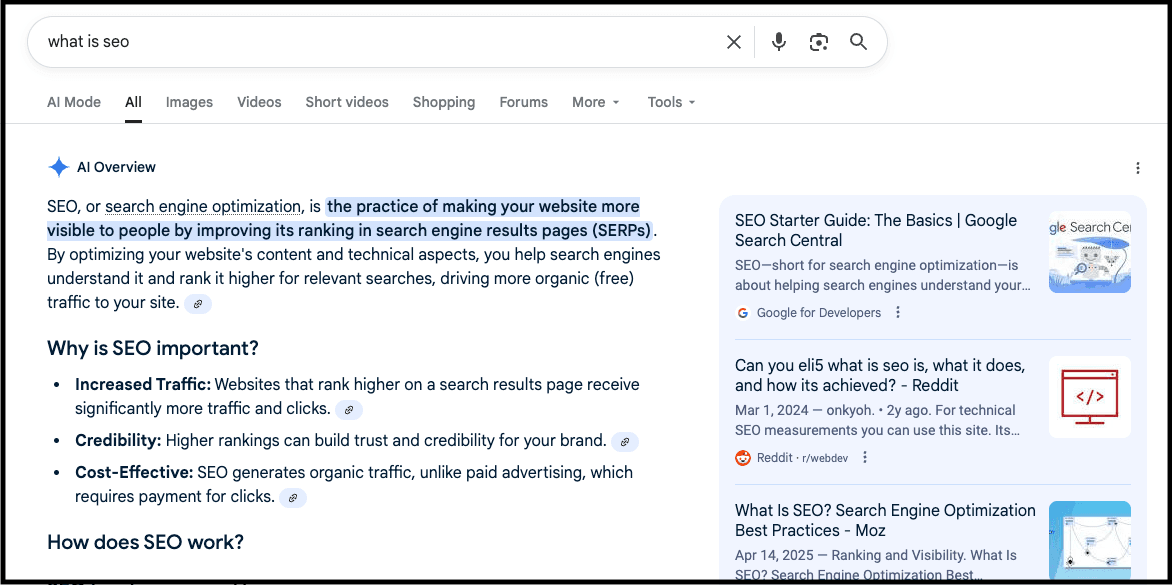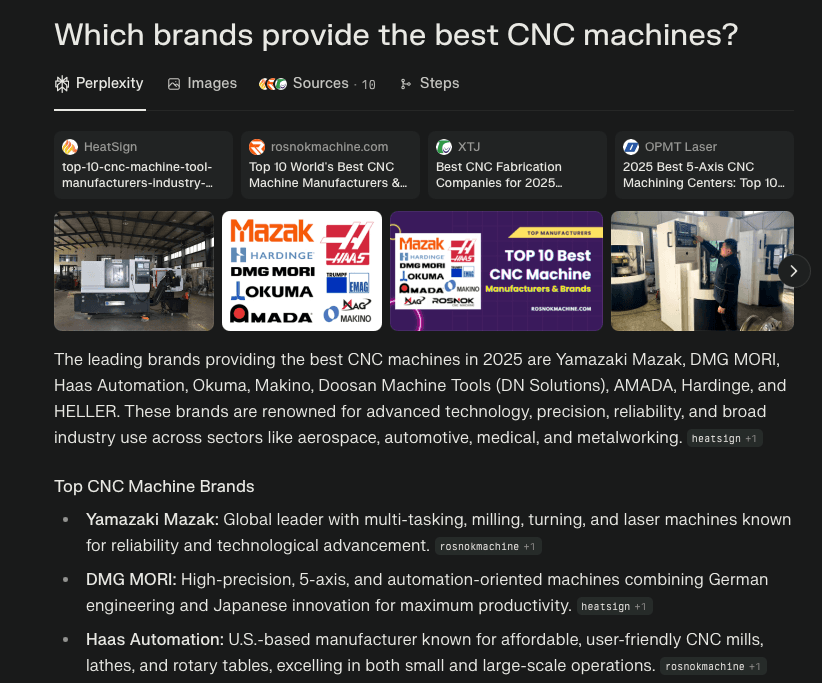
| Want LLMs to frequently cite and recommend your brand? Check out our AI Discovery service! |
What is Legacy SEO, and Why Is It Over?
First, let’s explain what we mean when we say legacy SEO. We’re explicitly referring to tactics that were meant to manipulate search algorithms for better visibility. They’re technical tweaks that add no value to users but can trick algorithms into rewarding low-quality content with high rankings. Legacy SEO tactics of this nature include:- Keyword stuffing – Marketers would stuff content with target keywords to trick algorithms into thinking the content was highly relevant for related topics. Keyword stuffing often made content awkward or unreadable, which is why Google cracked down on it in recent years. Keyword stuffing provides no benefit in AI search.
- Meta tag keywords – It was also common to stuff keywords in meta tags and meta descriptions to reinforce relevancy. This is no longer necessary due to the advanced semantic understanding of large language models (LLMs).
- Link volume – On traditional search engines, backlink quality AND quantity both mattered. Thus, there was no shortage of ways marketers could rack up large numbers of medium-to-low-quality backlinks. LLMs don’t care about link volume, so this tactic is now obsolete.
Sitemap submissions and being crawler-focused
 Before LLMs, online visibility completely hinged on getting your site crawled and indexed by search engines. Thus, submitting an XML sitemap to Google and Bing was (and still is) an SEO best practice.
If your content isn't crawled and indexed, it won’t appear in any traditional search results. Pre-LLMs, this would render your content 100% worthless.
However, LLMs have theoretically changed the equation.
Imagine a fitness brand that has a lot of unindexed content.
However, through expert outreach, digital PR, and strong social media marketing, they’re able to get their content frequently mentioned and linked to by relevant, trusted fitness websites and news outlets.
Not only that, but members of their target audience regularly mention their name in social media posts and fitness threads on Reddit.
While LLMs can’t directly access unindexed content, the brand’s off-site mentions, editorial coverage, and backlinks can still establish it as a credible player in the fitness niche.
That means when LLMs fetch answers to fitness-related prompts, they could choose to cite the fitness brand as a source or recommend its products and services.
How is this possible?
It’s because LLMs are robust enough to infer meaning and context from mere mentions of a brand, not just from full-blown articles.
Granted, this is just a fictional scenario that we used to illustrate a point.
Making your site crawlable to search engines is still essential.
LLMs pull much of their content from Google and Bing’s indexes, so it’s very much worth submitting a sitemap.
The key point to understand is that submitting a sitemap won’t do anything to convince LLMs that your brand is worth citing.
Think about it like this: submitting a sitemap ensures you’re on the shelf, but brand mentions and contextual authority are what persuade LLMs to actually cite your content.
Before LLMs, online visibility completely hinged on getting your site crawled and indexed by search engines. Thus, submitting an XML sitemap to Google and Bing was (and still is) an SEO best practice.
If your content isn't crawled and indexed, it won’t appear in any traditional search results. Pre-LLMs, this would render your content 100% worthless.
However, LLMs have theoretically changed the equation.
Imagine a fitness brand that has a lot of unindexed content.
However, through expert outreach, digital PR, and strong social media marketing, they’re able to get their content frequently mentioned and linked to by relevant, trusted fitness websites and news outlets.
Not only that, but members of their target audience regularly mention their name in social media posts and fitness threads on Reddit.
While LLMs can’t directly access unindexed content, the brand’s off-site mentions, editorial coverage, and backlinks can still establish it as a credible player in the fitness niche.
That means when LLMs fetch answers to fitness-related prompts, they could choose to cite the fitness brand as a source or recommend its products and services.
How is this possible?
It’s because LLMs are robust enough to infer meaning and context from mere mentions of a brand, not just from full-blown articles.
Granted, this is just a fictional scenario that we used to illustrate a point.
Making your site crawlable to search engines is still essential.
LLMs pull much of their content from Google and Bing’s indexes, so it’s very much worth submitting a sitemap.
The key point to understand is that submitting a sitemap won’t do anything to convince LLMs that your brand is worth citing.
Think about it like this: submitting a sitemap ensures you’re on the shelf, but brand mentions and contextual authority are what persuade LLMs to actually cite your content.
The Decline of Organic Traffic
Many websites have seen sharp declines in organic traffic lately, which has caused some marketers to declare that SEO is no longer effective. In late 2024, a study by Rand Fishkin discovered that 60% of searches were zero-click searches, meaning users didn’t click on any organic results. Why is that? The main reason is the prevalence of Featured Snippets and AI Overviews. As an example, imagine that you wanted to learn the definition of SEO after hearing a coworker mention it in passing. You don’t have a website or need SEO services, you’re just really curious about what the term means. To find out more, you type ‘what is SEO’ into Google. Here’s what you’ll see: Right there at the top of the results page, you see the definition, including what the acronym means. That’s literally all you wanted to know, so you close the tab.
No clicks, no conversions. This is a zero-click search in action, and they occur all the time now.
Not long ago, informational searches like this presented an opportunity to drive traffic to marketing blogs.
Today, AI Overviews and Featured Snippets satisfy most quick fact-finding queries instantly. That means far less traffic flows to top-of-the-funnel (TOFU) educational content.
Here’s the thing, though.
This isn’t a real loss.
A common factor most zero-click searches share is that the user was never going to convert anyway.
While zero-click searches from AI Overviews undoubtedly reduce traffic, it’s often low-quality traffic that wasn’t going to convert, so it’s not a big deal.
Moreover, if your TOFU content is top-tier, you could appear as a citation in an AI Overview, which will expose users to your brand name.
Clicks may have gone down, but the quality of traffic that does reach your site has gone up.
Why is that?
It’s because AI search tools are excellent at separating the wheat from the chaff.
AI Overviews and summaries are able to filter out low-intent users who just want things like definitions and simple resources.
The traffic that they do deliver to your website comes from truly interested prospects who are genuinely in need of products and services like yours.
Right there at the top of the results page, you see the definition, including what the acronym means. That’s literally all you wanted to know, so you close the tab.
No clicks, no conversions. This is a zero-click search in action, and they occur all the time now.
Not long ago, informational searches like this presented an opportunity to drive traffic to marketing blogs.
Today, AI Overviews and Featured Snippets satisfy most quick fact-finding queries instantly. That means far less traffic flows to top-of-the-funnel (TOFU) educational content.
Here’s the thing, though.
This isn’t a real loss.
A common factor most zero-click searches share is that the user was never going to convert anyway.
While zero-click searches from AI Overviews undoubtedly reduce traffic, it’s often low-quality traffic that wasn’t going to convert, so it’s not a big deal.
Moreover, if your TOFU content is top-tier, you could appear as a citation in an AI Overview, which will expose users to your brand name.
Clicks may have gone down, but the quality of traffic that does reach your site has gone up.
Why is that?
It’s because AI search tools are excellent at separating the wheat from the chaff.
AI Overviews and summaries are able to filter out low-intent users who just want things like definitions and simple resources.
The traffic that they do deliver to your website comes from truly interested prospects who are genuinely in need of products and services like yours.
Why traffic reduction shouldn’t induce panic
Here’s an example of what we mean. Let’s ask Perplexity which brands provide the best CNC machines. From a marketing perspective, we’re a highly qualified prospect for CNC machine providers. Here’s the response: As you can see, Perplexity provides direct brand recommendations. If you were an interested buyer, you would likely directly visit each brand’s website.
Now imagine that you do digital marketing for a brand like Yamazaki Mazak. If you only used legacy SEO metrics, you’d think that traffic was down (since they didn’t visit your site through a Google results page).
However, Perplexity just delivered a solid lead to you on a silver platter.
That’s why marketers need:
As you can see, Perplexity provides direct brand recommendations. If you were an interested buyer, you would likely directly visit each brand’s website.
Now imagine that you do digital marketing for a brand like Yamazaki Mazak. If you only used legacy SEO metrics, you’d think that traffic was down (since they didn’t visit your site through a Google results page).
However, Perplexity just delivered a solid lead to you on a silver platter.
That’s why marketers need:
- A new set of SEO metrics
- A new set of SEO tactics
Why Legacy SEO Fails in 2025
To understand why legacy SEO is no longer viable, you need to understand how LLMs select the sources that they cite:- AI prioritizes authority and trust, not just density – LLMs don’t care how many links you have, just that they’re authoritative and come from relevant, trustworthy sources.
- Thin content is penalized by E-E-A-T – Google doesn’t rank thin content (less than 700 words), and AI tools don’t like it either. If you want your content to succeed, it needs to be detailed, showcase expertise, and exhibit real-world experience. Whether you’re producing content for search engines or AI tools, it should embody E-E-A-T (experience, expertise, authoritativeness, and trustworthiness).
- Sentiment and real-world validation matter – LLMs want to see that users and customers view your brand as reputable and high-quality. Because of this, they check for reviews and community brand sentiment (like your mentions on Reddit and Quora).
What Comes Next? Generative Search Optimization (GSO)
SEO has effectively morphed into GSO, which stands for generative search optimization. The game is now about establishing authority with LLMs to earn citations and direct brand recommendations. Here’s a look at some of the emerging best practices for GSO.Entity-first optimization
If you want to get cited, you first need to establish your brand as a distinct and trusted entity in your field. When we say entity, we’re not referring to a ghost or spirit. Instead, we’re talking about named entity recognition (NER), which is how LLMs identify and distinguish things like people, places, organizations, and more. How can you establish yourself as a relevant entity? First, you should audit and map all your key brand entities, like your brand name, products, services, and so on. From there, audit how your branded entities appear in knowledge bases like Wikidata, GitHub, Google’s Knowledge Graph, and Crunchbase. Ensuring accuracy here is key because entries in these databases impact how LLMs understand your brand. Next, you should earn high-quality citations and backlinks on trusted, relevant websites. These trust signals are what solidify your brand as a reliable resource for prompts related to your niche. Also, including semantic HTML and schema markup makes your content easier for LLMs to parse, which can aid with entity recognition. Lastly, producing consistent E-E-A-T content that covers topics in great detail establishes topical authority, which significantly boosts NER.Trust signals instead of raw backlinks
Remember, editorial quality, semantic relevance, and brand sentiment are the strongest trust signals to LLMs. You no longer need to worry about backlink quantity, so you should put everything into ensuring the quality of your link placements. Digital PR is excellent for this, as it focuses on building backlinks and brand mentions on authoritative websites. In GSO, one editorial placement is way more valuable than scores of low-quality backlinks.Distributed authority across the web
LLMs don’t stick with one type of source when fetching content to generate answers to prompts. Instead, they cross-reference claims and check multiple types of content, such as:- News sites
- Media outlets
- Relevant blogs
- Community forums
- Industry publications
- Social media
How The HOTH Helps You Make the Transition to GSO
We haven’t been sitting twiddling our thumbs while the entire search landscape transforms around us. Our team has been closely monitoring the evolution of AI search since its inception back in 2022, and we’ve altered our product line accordingly. We now feature services tailored for GSO, such as:- Digital PR services to earn premium editorial backlinks and brand mentions
- Review and Reputation Management to ensure positive brand sentiment
- AI Discover to generate more AI citations and brand recommendations
Final Thoughts: The End of Legacy SEO
To summarize, legacy SEO is obsolete, and GSO is here to take its place, but it’s important to act now. What does this mean for marketers? Legacy SEO isn’t coming back, so it’s essential to make the transition to GSO as soon as possible. Regardless of what you do, you’ll continue to see your organic traffic decline, as it will for all websites. Yet, if you make the jump to GSO, you’ll remain relevant online, and your audience will be highly engaged and far more likely to convert than traditional organic visitors. Do yourself a favor and don’t go down with the ship. If you’re ready to make a successful transition to GSO, book a call with our team right now!The author
Rachel Hernandez
description
Previous
Buying Content in 2025: What to Look For (and What to Avoid) in the Age of AI
Next
From Keywords to Entities: The Evolution of Search Understanding
Discussion
Comments
ALOKHNATH PS
October 12th, 2025
Old SEO tactics like keyword stuffing are no longer effective. With AI and zero-click searches changing user behavior, building true authority and securing quality brand mentions are now essential. Trust, helpful content, and expertise drive success in today’s search landscape.
In addition to generative search optimization, offering interactive tools and unique resources can set a brand apart and encourage direct engagement, strengthening reputation with both users and AI systems. This perspective highlights new ways to grow visibility and credibility in an evolving digital environment.Seo Agency In Pakistan
October 10th, 2025
Excellent read! The evolution from legacy SEO to GSO really highlights how digital marketing is changing. Focusing on authority, trust, and quality content instead of outdated tactics is definitely the smart move for long-term online success.
Louise Savoie
October 9th, 2025
This article really highlights how much SEO has changed. I like how it explains that traffic drops don’t always mean failure, especially with AI Overviews and zero-click searches.
The shift from legacy SEO to GSO makes a lot of sense focusing on authority, trust, and brand mentions feels more aligned with how AI understands content now. Great read and thanks for sharing!

